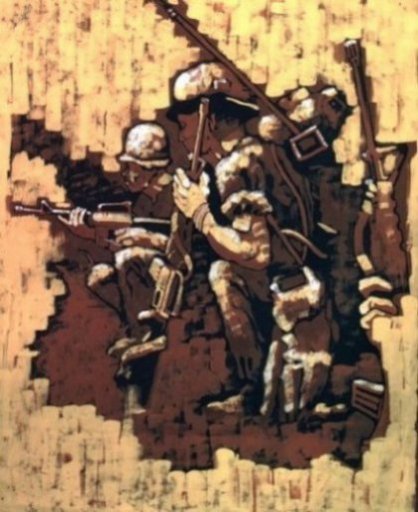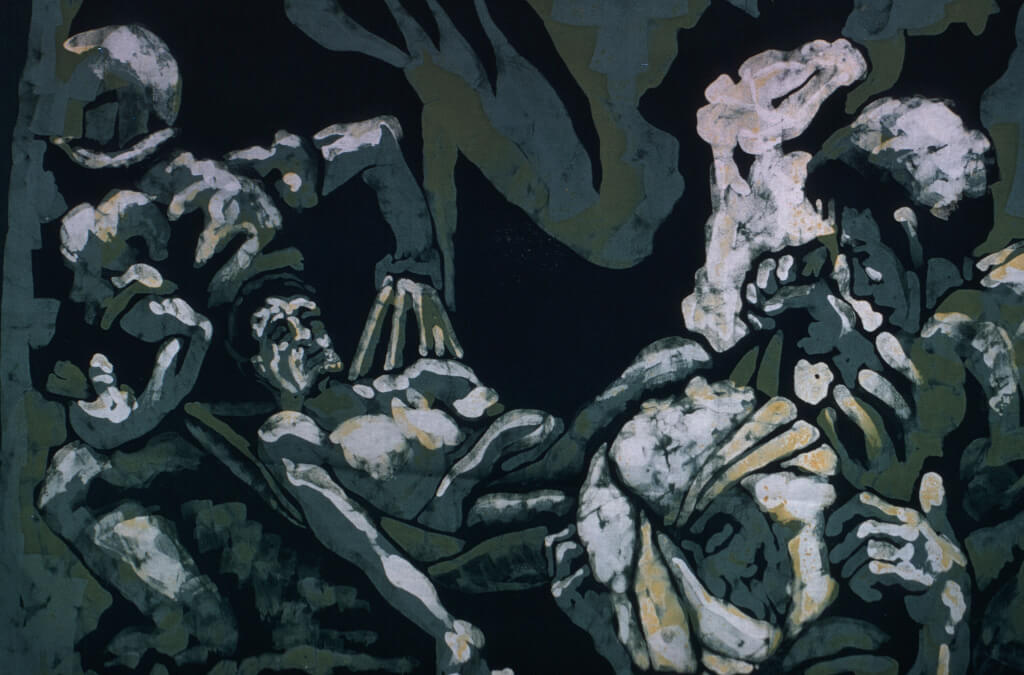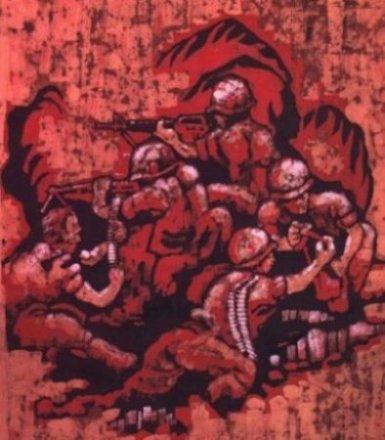
 A Minnesota PBS Initiative
A Minnesota PBS Initiative
Two ARVN Highland Scout Companies of the ARVN 24th Special Tactical Zone, the 403rd and the 406th, accompanied by myself and another advisor, were given orders to try to locate the 24th NVA Regiment in the vast Chi Ro Bu Mountains. The Chi Ro Bu Mountains are rugged and covered with triple canopy rainforest. They are located in northern Pleiku Province, just over the border from Kontum Province and just east of Highway 14, which runs from Pleiku to Kontum and on to Dak To.
Nearly all the Scouts were Montagnards while the officers were Vietnamese. The Montagnards are the indigenous peoples of the Central Highlands of Vietnam. The term Montagnard means "mountain people" in French and was carryover from the French colonial period in Vietnam. The Highland Scouts were basically reconnaissance units, lightly armed with only M16 rifles, hand grenades, M79 grenade launchers and a couple M72 LAWs.

SILENT SWEAT by Stephen H. Randall, Vietnam Combat Artists Program, CAT VII, 1968. Courtesy of the U.S. Army Center for Military History.
Early on August 16th, we loaded onto trucks, which drove us from the Scout Compound in Kontum to a spot on Highway 14 where we made our way into the mountains. The two companies of the Scouts had different assigned objectives, which took them on different but parallel courses. The idea was that if one of the companies got into trouble, the other company could come to its assistance. We advisors were assigned to accompany the 406th Company. I was thankful for that, as the 406th Company Commander was an arrogant ass but an excellent officer.
It was known that the 24th NVA Regiment had plans to attack Kontum City. ARVN units had been trying to locate the 24th NVA Regiment in the Dak Akoi River valley northeast of Kontum City where the NVA were staging for their attack. Under pressure from these ARVN units, the NVA moved into the Ia Tower Valley and then possibly into the Chi Ro Bu Mountains.
Their apprehension was definitely affecting me as I also ended up packing extra ammo, hand grenades and a second spare radio battery.
The soldiers and officers of the two Scout companies assigned to the operation knew they were in for what could be a costly fight even though the Scouts were not supposed to get into a pitched battle with the NVA. They were just to try to confirm the presence of enemy units and try to pinpoint their locations and report back.
Before we left Kontum, I noticed that the majority of the Scouts were uptight and edgy, including the officers. Because of the stories coming back from the ARVN units in the Dak Akoi river valley, the Scouts were all taking this operation very seriously. I had been a Scout advisor for nearly a year and I had never seen them this apprehensive. I noticed the Scouts were issued and were packing more ammunition than they would normally carry. They knew this was going to be a tough operation. Their apprehension was definitely affecting me as I also ended up packing extra ammo, hand grenades and a second spare radio battery.

GET THEM OUT by Stephen H. Randall, Vietnam Combat Artists Program, CAT VII, 1968. Courtesy of the U.S. Army Center for Military History.
The trucks carrying the Scouts from Kontum to the jump off point arrived near mid-morning. The Scouts unloaded, formed up and the two companies headed off together to later split off and take on their own objectives. The first couple of klicks were on relatively flat ground. We passed a couple of overgrown old deserted villages, which gave me an eerie spooked feeling and I could sense the same in the Scouts around me.
The flat ground gave way to foothills and the foothills to the steeper mountains. The tree cover went from the grass and single canopy of the flat ground to the double canopy of the foothills to the triple canopy rainforest of the steeper mountains. Along the way, we observed heavily used trails leading from the foothills and heavy rainforest to the highway.
These were probably trails used by NVA units when they moved to the highway to ambush US and ARVN convoys moving between Kontum and Pleiku. When we reached the thicker rainforest, we found locations where NVA units had made temporary positions, complete with foxholes and bunkers. A sense of apprehension seemed to permeate the Scout Companies.
We moved on and as light faded the two companies made their night positions as usual. After setting up defensive fire positions with our artillery support and checking with operations for any new intel or operational info, I sat outside my hammock and poncho shelter and looked up at the stars. The stars were so awesome that night, so bright, so beautiful and so peaceful and I wondered if I would make it out of these mountains.
An NVA soldier could be a yard away and you might not know he was there. It was deep, deep rainforest and very quiet, too quiet.
Later I got in my hammock and fell asleep to be awakened by voices. Some NVA soldiers in the darkness were yelling insults at my Scouts, who were too experienced to respond and give their positions away. There was even an NVA soldier who knew some English and would yell “You die soon Yankee”, knowing there was a couple of Americans with the Scouts. The NVA obviously knew the Scouts were here.
I quietly called in artillery fire on two of the predefined positions and the yelling stopped. Dawn came, rice was cooked and eaten and the companies split, each going its own way further into the Chi Ro Bu Mountains.
The 406th Company numbered about seventy-five rifleman and two officers. Of the three Scouts companies, they were the best and I took comfort in knowing I was with them as we humped to the base of Chi Ro Bu Mountain itself. The top at 1128 meters or 3700 feet above sea level was our next objective.
So far, we had not made contact with the NVA but we knew they were watching us as we moved through the rainforest. We were in triple canopy so visibility was mere feet in any direction. An NVA soldier could be a yard away and you might not know he was there. It was deep, deep rainforest and very quiet, too quiet.
We rested for a while, made commo checks, checked the map and wondered. Soon we were headed up the mountain.

FIREFIGHT by Stephen H. Randall, CAT VII, 1968, Courtesy of the National Museum of the U.S. Army.
We knew the NVA were near, and we knew they were watching us but we had objectives we had to carryout. We came to very steep terrain and an alarm came down the line. I moved forward to find out that the leading element had found steps cut into the mountain, complete with handrails in some places. The Scouts knew we were in the crap, facing a very large enemy force.
We did not take the steps for fear of bobby traps or ambush but instead made our own way up the mountain. At one point, we found commo wire running down the mountain. The Scout CO radioed the ARVN STZ HQ and relayed what we had found and was ordered to continue towards the next objective. Reluctantly the Scout CO ordered his men forward.
We continued up the mountain, sensing the enemy but not making contact. Before long, we came to the top of what amounted to a sort of hill or high ground on the side of big Chi Ro Bu Mountain. This hill was like a ridge that started but ended before it went anywhere. There was evidence that this area had been used recently, probably by some NVA unit for a night position. The company stopped here on the ridgeline that went nowhere and took a break. Many of the Scouts ate from rice balls, made from extra rice cooked in the morning. Soon the break was over and we pushed on up the mountain.
Story Themes: 1966, 1967, 1968, Army, ARVN, Booby Traps, Charles Schwiderski, Close Call, Fear, Kontum, MACV Advisory Team 24, Montagnard Troops, North Dakota, North Vietnamese Army, NVA, Read, Scouts, Terrain, West Fargo